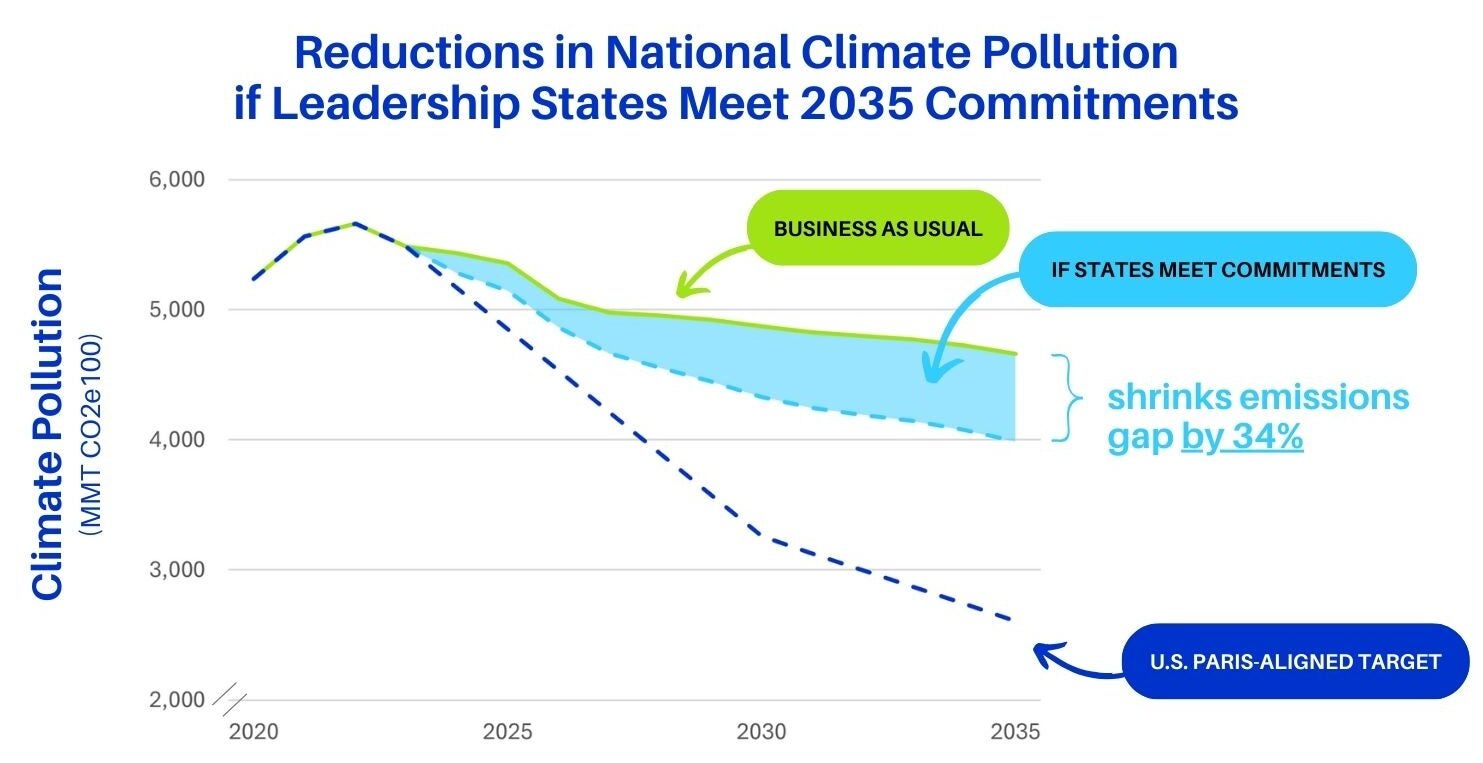While the federal government rapidly undermines climate progress, new analysis from EDF shows that state leadership is more important than ever. Our analysis finds that if leadership states deliver on their climate commitments, they could make a significant impact on the overall U.S. emissions and collectively cut the gap to the nation’s Paris-aligned 2035 target by a third.
What’s more, implementing the comprehensive and powerful policy tools state leaders have at their fingertips to meet these commitments would both slash planet-warming pollution and deliver household savings and economic benefits for communities. Now is the time for governors and state legislators to get the job done.
Urgency of state leadership amidst federal rollbacks
EDF’s emissions gap analysis examines the role U.S. states with climate commitments can play in shrinking the gap between projected emissions, based on current U.S. policies, and climate targets consistent with the U.S. targets from the Paris Agreement.
With the repeal of key provisions in the Inflation Reduction Act (IRA) and other federal moves to hinder the clean energy transition, the nationwide gap between projected emissions with policies in place today and Paris Agreement-consistent targets in the next decade is increasing. The analysis uses emissions data from Rhodium Group, updated earlier in September and EDF’s own projections for Oil & Gas methane.
Twenty-four states and territories in the U.S. Climate Alliance have made critical commitments to cutting pollution in line with the U.S. Paris-aligned targets. These climate leadership states collectively represent 57% of the U.S. economy and nearly 40% of total U.S. emissions.
Primarily due to federal rollbacks, including the repeal of the Inflation Reduction Act, U.S. emissions are expected to fall just 28% by 2035, well short of the 60% drop needed to meet Paris-aligned goals.
However, if leadership states follow through on their climate commitments, they could collectively cut this gap by about a third, pulling the country substantially closer to an emissions path consistent with the Paris Agreement.
In the coming years, governors and state legislators have a decisive opportunity to move the U.S. forward on science-based climate targets. At this critical moment, they should use the sharpest tools available — policies to directly limit climate pollution from major emissions sources — to deliver on their climate commitments. Not only are these policies capable of cutting emissions at the scale and certainty required, they also can drive significant cost savings for households and act as the centerpiece of a state’s affordability agenda.
Leveraging cap-and-invest programs to close the emissions gap and cut costs
One of the strongest policy tools available to states are cap-and-invest programs, which place a declining limit on emissions, require polluters to purchase allowances for each ton of emissions, and invest proceeds to accelerate an affordable, equitable clean energy transition. By putting a price on climate pollution, these policies ensure no low-cost emissions reductions are left on the table. In other words, cap-and-invest programs put states on the lowest-cost path to meeting their climate targets.
What’s more, cap-and-invest programs deliver real cost savings for households. Specifically, investments support energy affordability through direct rebates or energy bill credits and by helping consumers quickly and cheaply access clean energy and efficiency upgrades that will cut their energy costs year over year. Programs and rebates like these are more essential than ever, given the gutting of federal tax credits for efficiency upgrades. Community investments can also support benefits like climate resilience, cutting toxic air pollution, and job-creating infrastructure projects that yield net economic benefits.
As federal actions push emissions upward, state cap-and-invest programs provide a critical backstop. In fact, EDF’s analysis shows states that have cap-and-invest policies in place, especially those covering the whole economy, are mostly maintaining their emissions reduction trajectory even in the face of federal backsliding. Their progress reflects the capacity for this type of state leadership to guard against federal policy changes as well as other broader trends that can affect emissions projections. A cap provides certainty that emissions will lower even under a range of uncertain future conditions.
States leading the way on climate ambition and affordability
States have made major moves recently to scale up the ambition of existing cap-and-invest programs while cutting costs for communities, and these changes have garnered strong support from consumers and business. Moreover, recent analyses show that many more states can realize the same benefits by advancing similar programs.
California: Just this month, California lawmakers agreed to reauthorize cap-and-invest, extending the precedent-setting program and aligning the emissions cap with the state’s 2045 net-zero target. With this move, the state is projected to save families $3.9 billion, create 287,0000 new jobs and generate $55 billion in statewide economic growth while slashing emissions.
In signing the package of climate and energy bills, Governor Newsom said:
“I just signed into law the biggest electricity bill refunds in a decade — up to $60 billion to help bring down costs for California families […] we’re doubling down on our best tool to combat Trump’s assaults on clean air – Cap-and-Invest – by making polluters pay for projects that support our most impacted communities.”
Regional Greenhouse Gas Initiative (RGGI): This summer, ten northeastern states participating in RGGI concluded their Third Program Review and announced updates that strengthen the regional cap on power sector climate pollution, beginning in 2027. Since the program’s inception, over $9 billion in program investments have benefited over 8 million households including saving ratepayers a projected $20 billion on energy bills.
Announcing this historic multi-state agreement Elizabeth Mahony, Commissioner of the Massachusetts Department of Energy Resources and Chair of the RGGI, Inc. Board of Directors said:
“The improvements to RGGI announced today by this bipartisan group of states will ensure our consumers enjoy the economic and environmental benefits of clean, more affordable energy. RGGI has a proven track record of delivering big benefits for our states for more than 15 years, and today we are putting it on track to continue those benefits for years to come.”
Washington: Last fall, Washington voters rejected a ballot initiative to repeal the state’s landmark cap-and-invest program by a resounding 2:1 margin, successfully defending one of the most ambitious climate policies in the country as the on-the-ground benefits were clear. In the next decade, the program is expected to create 40,000 new jobs and unleash $9 billion in economic growth. The program is supported by a coalition of over 500 organizations including Tribes, labor unions, businesses and environmental groups.
The greater the climate ambition, the greater the affordability and economic benefits
These leading examples from California, Washington, and RGGI are further supported by recent analyses showing that many more states across the country have the opportunity to realize affordability benefits for their residents through ambitious climate action. And, what’s even more exciting is that the benefits scale with ambition: the more ambitious, the more net savings can accrue to households — particularly low to moderate income.
For instance, a recent study by Resources for the Future explores the effect of a cap-and-invest program applied to the electricity sector in eight leadership states (Arizona, Colorado, New Mexico, Illinois, Michigan, Minnesota, Wisconsin, and North Carolina), with revenues returned to residential ratepayers. The analysis finds that in each of the leadership states modeled, states can align power sector emission trajectories with their climate commitments while reducing household electricity costs. Specifically, households see electricity prices fall by 6% on average as a result of implementing this policy across the states modeled.
One of the study’s authors, Dallas Burtraw, a leading environmental economist summarized the results this way:
“Our research suggests that states don’t have to sacrifice climate ambition for affordability, in fact – it’s the opposite. At a time when decreased federal clean energy investment is costing ratepayers, we find that every state we model can use carbon pricing, such as a cap-and-invest program, to achieve environmental goals and concurrently actually reduce household electricity costs.”
New York has been developing regulations for an economywide cap-and-invest program. Draft rules are currently stalled, but evidence shows that the state can immediately cut pollution in line with its climate targets and deliver savings for households by moving this program forward. Analysis of New York’s proposed program shows that with a targeted dividend approach, nearly all households earning under $200,000/year will see net savings under cap-and-invest. These savings grow as households electrify or adopt efficiency measures – actions that the program incentivizes. For instance, another study shows that cap-and-invest could help 46% of households upgrade to clean, efficient heat pumps by 2035, saving the average household up to $1,022 per year. If New York follows in California’s footsteps, the two states alone could close the gap to the 2035 target by over 10%. The longer it takes New York to adopt the program, the longer it will take for these critical savings for households to materialize.
The nation’s current gap to Paris Agreement-aligned targets calls for state leaders to go big on climate ambition, using powerful policies that limit pollution. The evidence is clear and growing as more states step up: delivering on climate ambition can go hand in hand with delivering on affordability.











